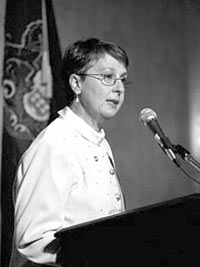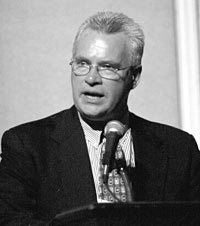Newsletters
- Home
- Publications
- Newsletter Archive
- Newsletter
January/February 2002
Inside This Issue:
- Center Announces 2002 Grant Projects
- 2002
Grant Projects
- Chairman's Message
- Rep. Hanna Joins Center Board of Directors
- Postsecondary Enrollment, Persistence of Rural Students Examined
- Update Census 2000: Using the Web for Census Data
- Center Releases Parks and Recreation and Volunteer Firefighter Surveys
- Did You Know . . .
- Just the facts: Runs Like New
- Rural Summit in the City Scrapbook
Center Announces 2002 Grant Projects
The Center for Rural Pennsylvania kicked off the 2002 research grant program by sponsoring 12 grant projects that will add to our knowledge base on such topics as mental health and dental health care, adult literacy, and telecommunications.
The Center's Board of Directors met in October 2001 to select the projects and awarded more than $490,000 for research to be conducted by faculty members at two Penn State University campuses and five State System of Higher Education (SSHE) universities. Most projects began on January 2, 2002. This year's grant projects are summarized below.
2002 Grant Projects
Dental Service Supply and Demand for the Indigent Populations in Rural Pennsylvania
This project, conducted by Lisa Davis of Penn State University, will analyze both the supply of and demand for dental services among indigent populations in Pennsylvania. The supply analysis will look at medial assistance and state license data, and will examine recruitment efforts and the use of dental school rural practicums. The demand analysis will examine medical assistance data, school-screening data, and original survey data.
Needs
Analysis of Mental Health Services for Children and Youth in Rural
Pennsylvania
Dr. Frank Lindenfeld and Dr. Yvette Samson of Bloomsburg University
will assess the present mental health delivery infrastructure,
especially as it relates to children and youth from low-income
families, in a six-county rural area. The research will examine
services provided by type, provider, cost reimbursement, credentials
of providers, access to and delivery of services, and gaps in
services by category of service, degree of urbanization, and income
level.
Advanced
Telecommunications in Rural Pennsylvania
This research will analyze rural Pennsylvania's telecommunications
infrastructure. Dr. Amy Glasmeier of Penn State University will
conduct a detailed study of this infrastructure, while further
assessing planned telecommunications upgrades and the level of
market competition among telecommunications providers in rural
Pennsylvania. She will also examine regulatory and policy issues
related to the provision of modern telecommunications providers
in the state.
Integration
of Rural Transportation Systems in Pennsylvania
Twenty-five years after the enactment of the Rural Public Transportation
Operating Assistance Program, some areas of the commonwealth still
lack integrated transportation systems. Individual transportation
systems in rural areas operate without coordinating with other
publicly funded transportation systems that operate within their
jurisdictions. Dr. Bridget Jeffery of Edinboro University will
examine ways in which separate providers of transportation in
rural areas can integrate their public transportation services.
Policy
Recommendations for Rural Pennsylvania's Water and Wastewater
Infrastructure
Dr. Samuel A. McClintock and Dr. Beverly Cigler of Penn State
Harrisburg will examine the managerial, technical, and financial
capacity of rural Pennsylvania's water and wastewater infrastructure,
assess alternatives for maintaining future capacity, and suggest
policy recommendations concerning financing for meeting future
infrastructure needs. Rural areas that are not currently served
by public water and wastewater facilities will also be included
in the study.
The
Influence of Well Construction on Bacterial Contamination
Dr. William Sharpe of Penn State University will initiate this
project to find out if proper well construction can prevent bacterial
contamination in private wells. Bacterial contamination of private
wells represents a widespread, potential health risk to rural
residents. Inadequate well construction likely contributes to
the problem because Pennsylvania is one of only four states that
does not have statewide construction standards for water wells.
Nature
Based Tourism
Dr. E. L. Shafer of Penn State University will inventory nature-based
tourism programs, which include non-consumptive and consumptive
tourist activities taking place in natural settings. The study
will include an inventory of nature-based programs in this state
and seven other states, and the development of a strategic plan
that identifies the role of state government in the promotion
and development of nature-based tourism in rural Pennsylvania.
Assessment
of Agricultural Use and Potential of Reclaimed Mine Lands in PA
The goal of this project, conducted by Dr. Charles E. Williams
of Clarion University, is to provide the information needed by
policymakers to make an informed decision on the value of agriculture
as a land use option for reclaimed mine lands in Pennsylvania.
The project will provide a regional overview of agricultural practices
on reclaimed mine lands in the Appalachian region and a focused
assessment of the current and potential agricultural uses and
productivity of reclaimed mine lands in the state.
Adult
Literacy in Rural PA
Increased global competition and rapid growth of computer technologies
have created a need for continuous adult literacy education. Dr.
Wenfan Yan of Indiana University of Pennsylvania will investigate
the extent that rural Pennsylvania adults participate in literary
and basic skills education. He will also examine the infrastructure
and funding streams supporting literacy programs in rural areas.
Rural
PA's "New Economy": Identifying the Causes of Growth
and Developing New Opportunities
One important state issue is the increasing gap between rural
and urban earnings. Dr. Martin Shields of Penn State University
proposes that one explanation for this gap is the relatively slow
transformation of rural areas to the "new economy."
As part of the project, he will develop an economic model that
will help improve our understanding of the causes of "new
economy" growth, and provide rural economic development practitioners
with a tool to identify prospects for local growth.
Mini
Grants
Impact of Mandatory Managed Care for Medicaid Clients on the Delivery
of Mental Health Services to Children and Adolescents in Rural
PA
Dr. Kimberly J. Husenits of Indiana University of Pennsylvania
will compare HealthChoices Mental Health MCO use and enrollment
for children and adolescents in urban and rural counties in Pennsylvania's
Southwest zone. She will examine Census data and/or epidemiological
data to determine risk factors related to mental health needs
along with Medicaid enrollment statistics. Specifically, the research
is looking at whether the application of the current mental health
delivery system negatively impacts rural children and adolescents.
Exploring
Public Housing Use in Rural PA
Dr. Pamela C. Twiss of California University of Pennsylvania will
use existing data and a survey of rural housing authority executives
to describe the public housing stock in rural counties, and to
explore whether patterned changes have occurred in its use. She
will also look for data on the perceived causes of changed use,
and the role the state may play in maximizing the use of this
housing.
Continuing
the process
As this year's grantees begin their projects, the Center for Rural
Pennsylvania is ready to begin the yearly grant process again.
The Center's Board of Directors has identified additional research
topics that address relevant issues impacting Pennsylvania's rural
residents. The Center will announce the topics in its 2003 Request
for Proposals (RFP), which will be issued in February.
While the Center's grant program is only available to faculty
at SSHE and Penn State universities, the Center encourages cooperation
and collaboration between these faculty and other public or private
organizations on grant projects.
For more information about the 2003 RFP or to receive a copy, call the Center at (717) 787-9555 or visit our website at www.ruralpa.org.
Chairman's Message
What a great way to wrap up the year. The Rural Summit in the City, sponsored by the Center for Rural Pennsylvania and held November 13 & 14 in Harrisburg, proved to be educational and thought-provoking. Overall, 168 people participated in this first Rural Summit, and they had some good things to say about their experiences during the two-day event.
Here are just some of their comments: "Great job. Looking forward to a future summit;" "The information of the summit is excellent. It is not reaching some of the individuals most in need;" "Great, eclectic mix of participants. Wonderful networking;" "The conference overall was well thought-out and organized. Thank you. I hope it becomes an annual conference."
The success of the Rural Summit was due in large part to our great speakers, who brought ideas from as close to home as Columbia, Washington, Potter and Lancaster counties, and as far away as Washington, DC, Galeton, NC, Kansas City, MO and Mississippi State, MS. Speakers like Bo Beaulieu, director of the Southern Rural Development Center at Mississippi State, who told us more about the concepts behind Assets-Based Community Development; Mark Drabenstott, director of the Center for the Study for Rural America, who shared his thoughts on the future of rural areas nationwide; and Rick Smyre, president of Communities of the Future, who told us how we can change our way of thinking to work our way into the future.
Our featured speaker on Tuesday evening, John Comey, executive assistant to the director of the Pennsylvania Emergency Management Agency, also provided us with valuable information on the emergency management issues affecting rural areas, the state, and our nation.
A scrapbook of photos from the Rural Summit is featured on page 4. Our thanks to everyone who participated and attended.
To hail in the New Year, we've started our 2002 grant projects, which are featured on page 1. Once again, we have a wonderful mix of projects being conducted by faculty of the State System of Higher Education universities and Penn State University. The projects will examine a variety of timely issues and will provide information for practitioners and policy makers alike. We'll update you on the results of these projects when they are completed and approved by our board of directors.
One project recently completed through our Grants Program and featured on page 5 offers information on postsecondary enrollment and persistence of rural students. The report offers sound policy implications and suggestions and is worth a careful read. Contact the Center for a copy of the report.
Other
Center-sponsored research is highlighted on page 6 as well as
our latest update on the Census.
As we welcome the New Year, we also welcome Representative Mike
Hanna of Clinton County to the Center's board of directors. Rep.
Hanna is a strong supporter of rural Pennsylvania and we look
forward to his participation on the board.
Representative Sheila Miller
Rep. Hanna Joins Center Board of Directors
The Center for Rural Pennsylvania welcomes its newest board member, Representative Mike Hanna.
Rep. Hanna was elected to the Pennsylvania House of Representatives in 1990 to represent the 76th District in Clinton County. He currently serves on the Finance Committee, Game & Fisheries Committee and Tourism & Recreational Committee.
He is also a member of the House Rural Caucus, which is composed of 12 House members from both parties who share a common interest in representing the needs of rural Pennsylvanians.
Rep. Hanna is a member of the Clinton County Economic Partnership and an officer in the Central Mountain Wildcat Booster Club. He is a graduate of Lock Haven University and the University of Pittsburgh School of Law.
Postsecondary Enrollment, Persistence of Rural Students Examined
By January, most rural high school seniors have an idea of what they'll be doing after graduation. Some will be heading off to college or trade school while others may be entering the workforce or the armed forces.
Of those that plan to attend college, how many will actually complete their studies and what factors influence their decision to continue their studies or to drop out? And what about those that decide to enter the workforce? What kind of jobs do they find and how much do they earn?
According to a report now available from the Center for Rural Pennsylvania entitled, Postsecondary Enrollment and Persistence of Students From Rural Pennsylvania, fewer rural students attend college after high school graduation than urban and suburban students. Dr. Wenfan Yan of the Indiana University of Pennsylvania used data from the National Educational Longitudinal Survey (NELS: 88/94), which is collected by the National Center for Educational Statistics, to determine that 52 percent of rural students attend college after graduating high school compared to 72 percent of urban students and 64 percent of suburban students.
Overall, among rural, urban and suburban students who enrolled in college, about 72 percent persist in their studies, 16 percent drop out and 13 percent enroll a year or more after high school graduation.
Positive
influences
Also according to the report, factors that seem to positively
influence rural students' decisions to complete their studies
include more financial aid options, high school policies that
foster early preparation for college, parental involvement in
children's decisions to attend college, positive peer relationships,
policies that promote transfer from two-year to four-year colleges,
and programs to increase career awareness and development among
students.
Off
to work we go
Among the students who did not go to college, 51 percent of rural
students entered professions requiring manual labor, while 22
percent of urban and 35 percent of suburban students did so. More
specifically, 51 percent of rural high school graduates were employed
as laborers or craftspeople, 26 percent were sales or service
workers, 9 percent were clerical workers, 5 percent were military
personnel, 3 percent were professionals and 3 percent were farmers.
Rural
high school graduates who did not go to college worked 41 hours
per week on average, similar to suburban students at 39 hours
per week, but slightly more than urban students who worked 35
hours per week.
The average monthly income of rural high school graduates who
did not go to college was $1,023, which was very similar to the
monthly income of suburban graduates but more than urban graduates.
The report provides more details on how the study was completed
and also offers important policy implications and recommendations
on how to improve the postsecondary enrollment and persistence
for Pennsylvania high school students.
Want
more info?
For a copy of the report, Postsecondary Enrollment and Persistence
of Students From Rural Pennsylvania, contact the Center for Rural
Pennsylvania at (717) 787-9555 or email info@ruralpa.org.
Update Census 2000: Using the Web for Census Data
Now that the basic population and housing data is available from the 2000 Census, the country is eagerly awaiting the gritty details of the socio-economic data. The existing figures from the SF1 (Summary File 1) or "short form" data provide everything from population by single year of age to specific Asian race, and Hispanic origin categories. This information can be compiled down to the census block level of geography so we can examine neighborhood information.
Also recently
released was a Congressional District Demographic Profile of selected
population and housing characteristics for each district of the
106th Congress.
One very easy way to access all of this information is the Internet.
The U.S. Census Bureau's website at www.census.gov has a link to the bureau's American FactFinder, an online database
to retrieve information from a number of its surveys.
Some very simple tables on your specific community are available from the Basic Facts section seen first on the page. Extensive data tables are also not difficult to obtain. By selecting the Census 2000 Data Set for the SF1 data, you can get to the items mentioned above. The Detailed Tables option allows the user to select the geography or geographies desired as well as the pieces of data to be included. It outputs an html table that can easily be pulled into Excel or other applications for formatting and making calculations.
Check it out and feel free to call the Center for Rural Pennsylvania with any questions. If the web is not for you or if you don't have access, the Center is always ready to answer your data needs.
The next numbers we see will be the SF2 (Summary File 2) data, which will be released between December 2001 and March 2002. This file will include detailed race and Hispanic origin breakdowns of all the SF1 population and housing information. With this information, we will be able to find out how many Samoans in Pennsylvania are homeowners or how many Whites in Adams County are 85 years old or older. As long as the population examined is not too small to breach confidentiality, the data can be obtained.
For more Census 2000 information, visit the U.S. Census Bureau's website at www.census.gov or call the Center for Rural Pennsylvania at (717) 787-9555.
Center Releases Parks and Recreation and Volunteer Firefighter Surveys
The Center for Rural Pennsylvania is releasing the results of two recently completed surveys conducted in-house with the assistance of other organizations.
Parks
and Rec report
The first survey report entitled, Recreational Issues in Pennsylvania's
Small Municipalities, looks at the parks and recreation issues
of small boroughs and townships of the second class. The report
provides information on the types of parks and recreational facilities
and programs that are owned and operated by these municipalities;
whether recreation is an important issue to these municipalities;
and the other entities that provide recreational programs and
facilities to municipal residents.
Firefighter
Survey
The second report, Answering the Call - Recruitment and Retention
of Pennsylvania Firefighters, was conducted with the assistance
of the Pennsylvania Fire and Emergency Services Institute. The
report provides information on volunteerism and companies' abilities
to recruit, retain, and train volunteers and provide services
to their areas.
For a copy of either report, contact the Center for Rural Pennsylvania
at (717) 787-9555 or info@ruralpa.org.
Did You Know . . .
- There are three venomous species of snakes in Pennsylvania: the northern copperhead, eastern massasauga rattlesnake, and timber rattlesnake.
- Pennsylvania issued its first state highway map in 1925.
- There are nearly as many farms in the state's urban counties as there are in its rural counties. Urban counties are home to 21,713 farms and rural counties are home to 23,744 farms.
Just the facts: Runs Like New
For most rural residents, getting from point A to point B requires a car or truck. In choosing a vehicle, rural Pennsylvanians have a greater selection of dealers - especially used car dealers - than their urban counterparts.
According to the 1999 County Business Patterns, published by the U.S. Census Bureau, rural areas had 317 used car dealers, or 12 dealers for every 100,000 residents. In urban areas, there were nearly 775 dealers, or fewer than 8 dealers for every 100,000 residents.
Used car dealers are defined as those establishments primarily engaged in retailing used automobiles and light trucks, such as sport utility vehicles, and passenger and cargo vans.
With nearly 1,100 dealers, Pennsylvania ranks 4th in the nation in the number of used car dealers. Texas, Florida, and California have the most dealers, while North Dakota, Wyoming, Alaska, and Hawaii have the least.
On a per capita basis, the Keystone State ranks 31st in the number of used car dealers.
Within Pennsylvania, the counties with the most used car dealers are Allegheny, Philadelphia, and Lancaster - each with more than 55 dealers.
Among counties, on a per capita basis, Somerset, Blair, Clarion, and Bradford have the most dealers with over 19 dealers for every 100,000 residents.
Between 1990 and 1999, the number of used car dealers in rural Pennsylvania increased 43 percent. Urban areas saw a 45 percent increase. Nationally, there was an increase of more than 68 percent in used car dealers.
Corresponding to the increase in rural used car dealers is an increase in the number of licensed vehicles. According to state Department of Transportation records, between 1990 and 1999, the number of vehicles in rural areas increased more than 18 percent, while urban areas had a 10 percent increase. Nationally, there was a 14 percent increase in licensed vehicles.
In rural areas, used car dealers are finding buyers. According to the most current data from the Census Bureau, in 1997, rural used car dealers sales hit nearly $268 million.
Rural Summit in the City Scrapbook
On November 13 -14, 2001, the Center for Rural Pennsylvania sponsored the Rural Summit in the City, a two-day conference focusing on timely rural issues.
Participants at the Rural Summit had the opportunity to network, to learn more about local, state, and national programs and projects that benefit rural residents, and to discuss the future of rural Pennsylvania.

Dr. Stephan Goetz, Center
board member and director of the Northeast Regional Center for
Rural Development, Rep. Sheila Miller, Center for Rural PA chairman,
and John Comey, executive assistant to the director of the PA
Emergency Management Agency

participants at the
Tuesday evening dinner

Suzanne Benchoff, director
of Migrant Education, Lincoln Intermediate Unit 12

Kim Coon (standing)
president of the Educational Resources Group with the State System
of Higher Education

Berwood Yost, instructor
and director of the Center for Opinion Research at Millersville
University

Mike Young, professor
and director of the Center for Survey Research, Penn State University
at Harrisburg

Rep. Sheila Miller

and Barry Denk, director
of the Center for Rural Pennsylvania
